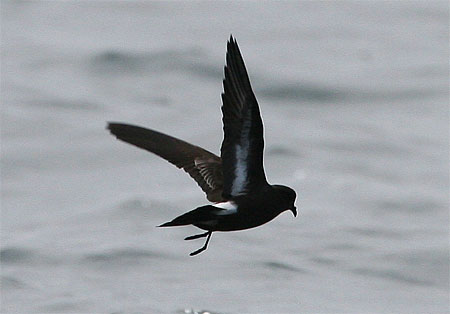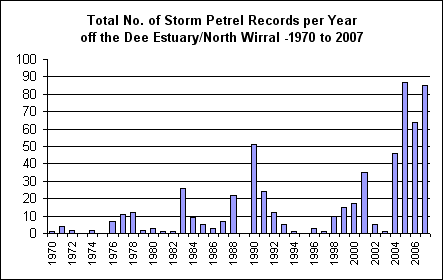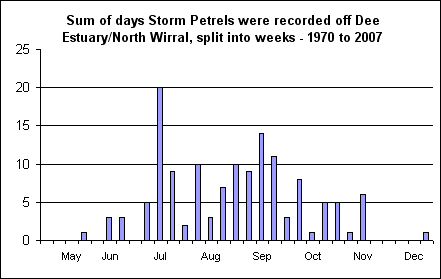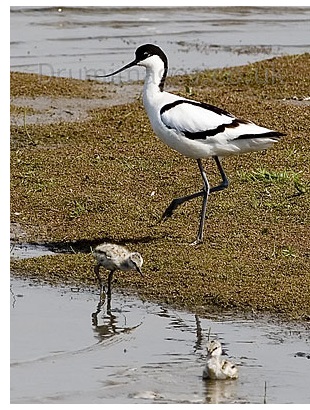Site menu:

June 2008 Newsletter
European Storm Petrel.
May Bird News.
Forthcoming Events.
Latest Newsletter.

Hydrobates Pelagicus - 'the Oceanic water-walker' - is a scarce bird off the Dee Estuary and North Wirral coast although records have increased significantly over the past four years. Properly called the European Storm Petrel it is more usually known in this country as just Storm Petrel, inevitably shortened by birders to 'Stormy'. Up until the 1980s many called this species the 'British Storm Petrel' but European is a far more appropriate name as it breeds in several countries within Europe but not outside Europe. Numbers of breeding pairs estimated to be present in the four most important areas are as follows: 270,000 on the Faeroe Islands, 95,000 in Ireland (including Northern Ireland), 75,000 in Iceland and 26,500 in the British Isles outside Ireland.
Storm Petrels are tiny by seabird standards, being just a bit larger than a House Sparrow. Despite their small size they are true oceanic birds and cope with Atlantic gales without problems, sailors often see them during storms close to ships as they patter over the waves taking advantage of the troughs to obtain some shelter. They are rarely seen from land as even in the breeding season they return to the nesting burrows only at night. Prolonged strong winds in the westerly quadrant can, however, bring a few within sight of our coast, mostly between June and October. But even then they are much harder to see than the larger Leach's Petrel as they tend to fly closer to the water and in between wave troughs. Often it's a case of a brief glimpse before they disappear again.

As can be seen in the graph above frequency of records off
the Dee Estuary and North Wirral have
increased significantly over the past four years. Peak counts for these years
were 30 on Sep 22nd 2004 (New Brighton), 30 on Jul 22nd 2005, 26 Aug 3rd 2006
and 42 on Aug 16th 2007 (2005 to 2007 all Hilbre), the latter being our highest ever
count. I don't pretend to know why there has been this increase, one thing for
certain is that it doesn't reflect an increase in the population as a whole as
numbers are fairly stable, probably with a small decrease. Here are a few of my
suggestions as to possible reasons for the recent increase, this is just
speculation so none might in fact
be true:
1. Possible increase in summer westerly winds, perhaps due to climate change.
2. Possible increase in observer awareness that this species can be present in summer,
rather than just during autumn gales, i.e. perhaps birders are sea-watching more
in the summer than they used to.
3. More food might be available locally in Liverpool Bay, perhaps due to overfishing of
bigger fish which may mean more smaller sea creatures are available as food for
the petrels rather than being consumed by fish.
4. If less food is available further out to sea then this might bring birds nearer land.
5. Last four years may have seen a better than normal survival rate of young birds
for an unknown reason (most birds we see here are likely to be non-breeding).
6. High numbers over the last four years may just be due to random fluctuations, numbers observed here are so small relative to
total population that it is not possible to draw any conclusions!

Adult birds winter far to the south, off South Africa, returning to their breeding colonies during April and May. Breeding is a protracted affair with the first eggs laid in early June, and the last fledged birds leaving their nesting sites not until early November, so that the return migration of adults is through October and into November. As can be seen from the graph above their is little evidence that we see very much of either migration, although the birds observed in late October and November may well be newly fledged birds blown inshore by Autumn gales. The graph shows number of days birds were seen, rather than number of birds per day - the logic being that it avoids bias towards the odd exceptional year when, say, 30 are seen in one day when the norm is just one or two birds per day. There is a definite sharp peak in mid-July which may be due to a wave of non-breeding birds moving north through the Irish Sea. It is interesting that the BTO Atlas mentions a large influx of birds into Shetland waters towards the end of July, presumably part of this same northward movement. The second peak in September is much less sharp and may be due to these same non-breeding birds returning south, and/or perhaps it is a reflection of the fact that we get more westerly gales in September so birds are more likely to be seen.

The map above shows the breeding colonies within the Irish Sea; do the birds we see come from these colonies? Probably not. Although the movements of breeding birds is not well understood it is thought that they do not move more than 60 miles away from their burrows whilst breeding, this means even the small numbers at Bardsey Island are unlikely to reach our shores. In contrast, ringing clearly shows that immature birds wander well away from breeding colonies. They also tend to arrive later and leave earlier than adults which ties in neatly with the second graph above. We can therefore reasonably conclude most of the birds we see here are these pre-breeding wanderers.
In the past few years Kieran Foster of the Merseyside Ringing Group has started ringing Storm Petrels along the North Wales coast at Little Orme and Point Lynas on Anglesey. The birds are lured in by playing the call of a Storm Petrel then caught in a net. So far 79 birds have been captured, more than 10% of which were already ringed or subsequently controlled (caught and recorded) elsewhere. Birds caught by Kieran along the North Wales coast have come from, or subsequently been found at: Northern Ireland, Sanda Island, Bardsey Island, St Kilda and the east coast of Scotland. The movements indicate that these are pre-breeding wanderers moving north through the Irish Sea during the summer. It will be interesting to see which breeding colonies Kieran's ringed birds turn up at when they eventually reach sexual maturity.
Sources of Information:
1. R.M. Lockley, Flight of the Storm Petrel, 1983.
2. Cheshire/Cheshire & Wirral Bird Reports - 1970 to 2006.
3. Clwyd Bird Reports, 1975 to 2003.
4. North-East Wales Bird Report 2004-2006.
5. Kieran Foster, Storm Petrel Ringing on the North Wales Coast, Merseyside
Ringing Group Annual Report 2006.
6. BTO Migration Atlas, 2002.
7. Seabird 2000 data extracted from: http://www.jncc.gov.uk/.
8. Hilbre Bird Observatory Data for 2007 (unpublished at time of writing).
May Bird News
 May this year was one of those months which seem to have
been very quiet, but when you look back at what has been seen you realise how
good it was! No doubt persistent east winds helped push migrants further
east than usual.
May this year was one of those months which seem to have
been very quiet, but when you look back at what has been seen you realise how
good it was! No doubt persistent east winds helped push migrants further
east than usual.
Pick of the rarities was a Whiskered Tern at Inner Marsh Farm, a first for Wirral. It stayed from the 9th to the 19th (with a possible further sighting on the 29th), giving many people fabulous views. Next was a Bluethroat which turned up on Hilbre on 21st, a first for Hilbre, it was a first summer male and stayed all day (photo, left, taken by Steve Williams). The Cattle Egret which turned up last month on the Hoylake Langfields stayed until 8th. There were two Red-rumped Swallows seen, one on Hoylake sea-front and another in the horse paddocks near Leasowe Lighthouse. The Cetti's Warbler by Neston Reed Bed has been somewhat elusive but still seems to have been present through the month. Not as rare but still nice to see were two Wood Sandpipers at Inner Marsh Farm and another near Gilroy Nature Park at West Kirby. A rarity not too far away from the Dee Estuary are the Black-winged Stilts breeding near Northwich, hence the sketch at the top of this newsletter!
|
Spring migration was still well underway early in the month with a good passage of Whinchats including four at Leasowe Lighthouse on two separate days. It has been a good spring for cuckoos which are now scarce in our area, a total of seven where seen and/or heard. Whimbrels continued to pass through including 43 over Thurstaston on the 1st, several Common Sandpipers were reported and there were six Spotted Redshank at Inner Marsh Farm on 3rd. At Inner Marsh Farm several pairs of Avocet have been breeding (see photo right, © Damian Waters), 300 or so Black-tailed Godwits are over summering there and a drake Garganey was observed a few times. Out to sea were 4,000 Common Scoter, a remarkable number for early May - presumably still on their way north to breed. A couple of Velvet Scoter were spotted among the Common. Little Tern numbers at Gronant had increased to 150 by the third week in May. Hobbys are undoubtedly increasing in our area, there were nine records this month including two on Burton Marsh. |
 |
Many thanks go to Adrian Foster, Alan Conlin, Stephen Menzie, Jason Stannage, Colin jones, Steve Williams, John Tubb, Chris Butterworth, Rob Swift, Charles Farnell, James Armstrong, Mike Jones, Richard Steel, Steve Renshaw, Dave Wild, Mike Cocking, Damian Waters, Nick and Linda Thomson, Steve Hasell, Ian Dyer, Paul Mason, Andy Thomas, James Astley, Kevin Smith, Steve Liston, Ian Emmitt, Dave Harrington, Frank Huband, Phil Woollen, Chris Tynan, John Smerdon, Alan Duckers, Mike Hart, Alan Price, Martin McDonnell, Mark Evans, Paul Vautrinot, Andrew Wallbank, Graham Jones, Stephen Ainsworth, James Smith, Chris Wilding, Gilbert Bolton, Jane Turner, Steve Round, Iain Douglas, Alec Thomasson, Mark O'Sullivan, Dave Edwards, Ken Mullins, Leon Castell, John Kirkland, Mark Evans, Tom Partridge, Philip Gilman and the Hilbre Bird Observatory for their sightings during May. All sightings are gratefully received.
What to expect in June
High Arctic breeding birds can still be on their way north at the beginning of the month - Dunlin, Ringed Plover and Sanderling - Gronant is a good place to see these late migrants speeding through. By the end of the month we will see the return of the early breeders with several hundred Curlew present at Heswall. Of the scarcer waders Green Sandpipers and Spotted Redshank finish breeding early and there should be one or two at Inner Marsh Farm. We also have over summering waders, some of which are breeding whilst others are immature non-breeders. Breeding waders include Ringed Plover and Oystercatchers, Gronant is a good place to see these - Oystercatchers are particularly welcome at the Little Tern colony as they are very effective at chasing away crows! Non-breeding waders include Black-tailed Godwits with several hundred usually present at Inner Marsh Farm.
The Little Tern colony at Gronant will be very busy with eggs being laid and by the end of the month the first chicks will have emerged. Out in Liverpool Bay we should see Arctic Skuas, Gannets, Manx Shearwaters, Common Scoter and maybe a Storm Petrel or two - particularly if there are some fresh west winds.
Red Kites sometimes turn up in June, a lovely bird to see but you have to have a bit of luck to see one. June is also sometimes a good month for the odd wandering Spoonbill, two turned up at Inner Marsh Farm last year and stayed all month.
Forthcoming Events
June Highest Spring Tides (Liverpool)
Also see
Tides page.
4th June, 12.16hrs (BST), 9.5m.
5th June, 13.08hrs (BST), 9.5m.
Forthcoming Events
Organised by the
Wirral Ranger Service ,
Flintshire Countryside Service and/or the RSPB:
All these events and walks have bird interest, even those not advertised
specifically for birdwatching. No need to book for these events unless
specified - please check below.
Thursday 5th June, 8pm – 10pm, Rock the Nightjars.
A 2½ mile stroll to watch our resident Nightjars perform their curious
display at dusk, in this geologically interesting area. Booking essential:
Loggerheads – 01352 810614 or 810586.
Meeting point: Coed Nercwys, nr Mold (SJ218592). Free.
Editor: A bit outside the Dee Estuary area but this sounded so
intriguing I thought I would put it in.
Thursday 5th June, 6pm – 9.30pm, Sunset Walk to
Hilbre.
Join the Ranger and cross the sands to discover the wildlife and history
of the Hilbre Islands Local Nature Reserve. This 4-mile walk of 4 hours is
ideal for first time visitors and suitable for all the family to enjoy,
although some people may find the walk strenuous in places. Warm
waterproof clothing and suitable footwear are essential. (Wellies are
recommended). Sorry no dogs. There is a £1 charge per person for this
event.
Booking essential, 0151 648 4371/3884 or
book on-line.
Saturday 7th June, 2pm Start, The Last 30 Years.
Senior Ranger James Locke invites you along to the Visitor Centre at
Wirral Country Park for a fascinating
illustrated talk on the first designated Country Park in England.
Booking essential, 0151 648 4371/3884 or
book on-line.
Saturday 14th June, 2pm Start, Strandline Search at
Talacre.
Dress for the beach and join ‘Marine Awareness’ from North Wales Wildlife
Trust, who will help you to find a few treasures of the sea! Booking
essential. Further details: Flintshire Biodiversity Officer, Sarah Brown -
01352 703263. Meeting point: Smugglers Inn car park, Talacre (SJ125848).
Free.
Saturday 14th June, 11am – 3pm, On the Trail of Summer.
Pop down to Wirral Country Park and
discover the signs of summer on this self-guided trail which will help you
see some of our summer specialties. This event is suitable for all the
family to enjoy and all children must be accompanied by an adult. No need
to book, just come along to the Wirral Country Park Visitor Centre,
Station Road, Thurstaston (CH61 0HN).
For further enquiries ring 0151 648 4371/3884.
Sunday 15th June, 10.30am and 2pm Start, A Walk around
Royden Park.
Join members of the Wirral Footpaths and Open Spaces Preservation Society
for a morning or an afternoon walk around Royden Park. This event is
suitable for all the family to enjoy. Sorry no dogs. Suitable clothing and
footwear are essential. No need to book. Meet at the main car park, Royden
Park, Hillbark Road, Frankby (CH48 1NP)
For further enquiries ring 0151 342 4462
Sunday 15th June, 12.30pm – 3.30pm, Telegraph Station Open Day.
The Friends of Hilbre will be opening the
best preserved Holyhead to Liverpool telegraph station which is now a
small visitor centre on the main island. Short Ranger-led tours of the
island and seal watching will also be taking place. The Friends will also
be staffing the Wirral Council Parks and Countryside Mobile Information
Unit at West Kirby Marine Lake Car Park (CH48 0QG) to provide advice about
safe crossing times and other information about the islands.
For further enquiries ring 0151 678 5488
Saturday 28th June, 9.30pm – 12 midnight, A Night on the Tiles.
Some of our most charismatic and interesting wildlife is nocturnal and
elusive and requires specialist equipment to see them. Join the Rangers on
this special moonlit naturewatch at Wirral
Country Park in the search for bats, owls, moths and other creatures
of the night. This event is suitable for all the family to enjoy and all
under 16 year olds must be accompanied by an adult. Sorry no dogs. Warm
clothing, suitable footwear and a torch are essential.
Booking essential, 0151 648 4371/3884 or
book on-line.
Thursday 9th July, 6pm – 9.30pm, Sunset Walk to
Hilbre.
Join the Ranger and cross the sands to discover the wildlife and history
of the Hilbre Islands Local Nature Reserve. This 4-mile walk of 4 hours is
ideal for first time visitors and suitable for all the family to enjoy,
although some people may find the walk strenuous in places. Warm
waterproof clothing and suitable footwear are essential. (Wellies are
recommended). Sorry no dogs. There is a £1 charge per person for this
event.
Booking essential, 0151 648 4371/3884 or
book on-line.
Sunday 13th July, 10.30am – 3.30pm, Through Dales and Woods.
Join the Rangers and members of Wirral Wildlife on a summer stroll through
heathland, woodland, along parts of the Wirral Way and along the shore of
the Dee Estuary. Suitable clothing and footwear are essential and a packed
lunch is recommended. This event is suitable for all the family to enjoy.
Sorry no dogs. No need to book. Meet at Cleaver Heath Local Nature Reserve
Car Park, Oldfield Road, off Telegraph Road, Heswall.
For further enquiries ring 0151 677 7594
|
 |
The blank (UK) Birding Webring is a collection of quality birding web sites that are based in the United Kingdom. Visit the webring homepage for more information, or A complete list of all the sites in the webring is available by clicking here. previous site in ring : random site in ring : next site in ring |